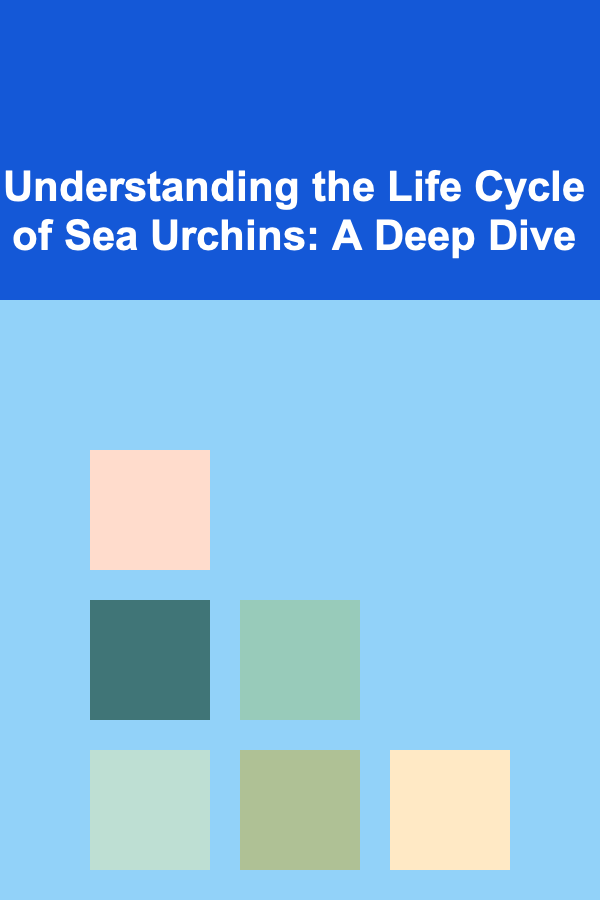
Understanding the Life Cycle of Sea Urchins: A Deep Dive
ebook include PDF & Audio bundle (Micro Guide)
$12.99$8.99
Limited Time Offer! Order within the next:

Sea urchins, those spiny inhabitants of the marine realm, are more than just pincushions of the sea. They are ecologically significant creatures with a fascinating and complex life cycle. Understanding this life cycle is crucial for marine biologists, conservationists, and anyone interested in the intricacies of the ocean ecosystem. This article delves into the various stages of sea urchin development, from fertilization to adulthood, exploring the biological processes, environmental influences, and ecological roles that shape their lives.
I. Introduction to Sea Urchins: Diversity and Ecological Importance
Sea urchins belong to the class Echinoidea, a group within the phylum Echinodermata, which also includes starfish, sea cucumbers, brittle stars, and crinoids. Characterized by their radial symmetry and spiny exoskeletons (tests), sea urchins are found in oceans worldwide, from shallow intertidal zones to the deep sea. There are over 950 known species, each adapted to specific habitats and ecological niches.
Ecologically, sea urchins play several vital roles:
- Herbivores: Many sea urchin species are herbivores, feeding primarily on algae. Their grazing activity is crucial in maintaining the balance of coral reef ecosystems and kelp forests. Overgrazing by sea urchins, especially in the absence of their natural predators, can lead to the destruction of these habitats, creating "urchin barrens."
- Prey: Sea urchins serve as a food source for various predators, including sea otters, sea stars, fish, crabs, and birds. Their presence supports complex food webs and contributes to overall biodiversity.
- Sediment Disturbers: Some sea urchin species burrow into the sediment, aerating the seabed and promoting nutrient cycling. This bioturbation influences the composition and health of benthic communities.
- Bioindicators: Sea urchins are sensitive to environmental changes, such as pollution and ocean acidification. Monitoring their health and abundance can provide valuable insights into the overall condition of marine ecosystems.
Their sensitivity to environmental factors makes understanding their life cycle even more crucial, as disruptions at any stage can have cascading effects throughout the ecosystem.
II. The Reproductive Cycle: Spawning and Fertilization
Sea urchins reproduce sexually, typically through external fertilization. This process relies on the synchronized release of sperm and eggs (gametes) into the water column, a phenomenon known as spawning. Several factors influence spawning, including:
- Lunar Cycles: Many sea urchin species exhibit lunar periodicity in their spawning behavior. The gravitational pull of the moon and the associated changes in tides and light levels often trigger mass spawning events.
- Temperature: Water temperature plays a crucial role in regulating reproductive readiness. Spawning usually occurs within specific temperature ranges, varying depending on the species and geographic location.
- Photoperiod: The length of daylight hours can also influence spawning cycles. Changes in photoperiod can signal the onset of the breeding season.
- Chemical Cues: Some sea urchin species may release chemical signals (pheromones) that induce spawning in nearby individuals, ensuring greater fertilization success.
The process of fertilization is highly dependent on the density of sperm and eggs in the water. High densities increase the likelihood of successful fertilization, while low densities can result in reproductive failure. Once sperm and egg meet, they fuse to form a zygote, marking the beginning of the next stage of development.
The cellular and molecular events that occur during fertilization are well-studied in sea urchins, making them a valuable model organism for developmental biology. The acrosome reaction, the fusion of the sperm and egg membranes, and the activation of the egg are all crucial steps in initiating embryonic development.
III. Embryonic Development: From Zygote to Pluteus Larva
Following fertilization, the zygote undergoes a series of rapid cell divisions called cleavage. This process transforms the single-celled zygote into a multicellular embryo without significantly increasing its overall size. Cleavage in sea urchins is radial and holoblastic, meaning that the divisions are symmetrical and the entire egg is divided.
The early stages of embryonic development include:
- Cleavage: The initial divisions result in the formation of blastomeres, which progressively decrease in size.
- Blastula Formation: After several rounds of cleavage, the blastomeres arrange themselves to form a hollow sphere called the blastula. The cavity within the blastula is known as the blastocoel.
- Gastrulation: Gastrulation is a critical stage in embryonic development during which the blastula undergoes extensive cell rearrangements to form the three primary germ layers: the ectoderm, mesoderm, and endoderm. These germ layers will eventually give rise to the various tissues and organs of the developing organism. In sea urchins, gastrulation begins with the invagination of the vegetal pole cells into the blastocoel.
- Formation of the Archenteron: The invagination of the vegetal pole cells forms the archenteron, the primitive gut. The archenteron eventually connects to the ectoderm, forming the mouth and anus.
After gastrulation, the embryo differentiates into a characteristic larval form known as the pluteus larva. The pluteus larva is a planktonic stage that feeds and develops in the water column.
IV. The Pluteus Larva: A Drifting Stage of Development
The pluteus larva is a unique and distinctive larval form of sea urchins. It is characterized by its bilaterally symmetrical body and elongated arms supported by calcareous skeletal rods. These arms, typically four in number, are covered with cilia, which are used for swimming and feeding.
The pluteus larva plays a crucial role in dispersal. Being planktonic, it can drift with ocean currents, allowing sea urchins to colonize new habitats and maintain genetic diversity across populations. The duration of the larval stage can vary from weeks to months, depending on the species, environmental conditions, and food availability.
Key features of the pluteus larva include:
- Skeletal Rods: The calcium carbonate skeletal rods provide structural support to the arms and body of the larva. These rods are synthesized by specialized cells called mesenchyme cells.
- Ciliary Bands: The ciliary bands are rows of cilia that beat in a coordinated manner to generate water currents for feeding and locomotion.
- Digestive System: The pluteus larva has a functional digestive system, consisting of a mouth, esophagus, stomach, and intestine. It feeds on phytoplankton, small algae, and bacteria.
- Nervous System: The nervous system of the pluteus larva is relatively simple, consisting of a nerve net that coordinates sensory input and motor output.
The development of the pluteus larva is highly sensitive to environmental conditions. Temperature, salinity, and food availability can all affect its growth rate, survival, and ability to metamorphose.
V. Metamorphosis: From Larva to Juvenile Urchin
Metamorphosis is the dramatic transformation of the pluteus larva into a juvenile sea urchin. This process involves significant changes in morphology, physiology, and behavior. It is triggered by a combination of internal developmental cues and external environmental signals.
Several factors can induce metamorphosis, including:
- Substrate Cues: The presence of suitable substrate, such as specific types of algae or biofilms, can trigger metamorphosis. The larva may recognize chemical signals or physical characteristics of the substrate.
- Chemical Signals: Certain chemical compounds produced by adult sea urchins or associated organisms can induce metamorphosis in competent larvae.
- Bacterial Films: The presence of bacterial films on surfaces can also promote metamorphosis. The bacteria may provide essential nutrients or produce signals that trigger the process.
During metamorphosis, the following key events occur:
- Resorption of Larval Structures: The larval arms and other larval-specific structures are resorbed. The nutrients and building blocks from these structures are recycled to support the development of the juvenile urchin.
- Development of Juvenile Structures: The juvenile urchin develops its characteristic radial symmetry, spines, tube feet, and jaws. The adult body plan is largely formed during this stage.
- Settlement: The larva settles onto the substrate and attaches itself using its tube feet.
- Shift in Feeding Behavior: The juvenile urchin transitions from filter-feeding as a larva to grazing on algae as a juvenile.
Metamorphosis is a critical bottleneck in the life cycle of sea urchins. Only a small percentage of larvae successfully complete metamorphosis and survive to become juvenile urchins. The success of metamorphosis depends on a variety of factors, including the health of the larva, the availability of suitable substrate, and the presence of predators.
VI. Juvenile and Adult Sea Urchins: Growth and Reproduction
Once metamorphosis is complete, the juvenile sea urchin begins to grow and mature into an adult. Growth rates vary depending on the species, food availability, temperature, and other environmental factors.
Key aspects of juvenile and adult sea urchin life include:
- Growth: Sea urchins grow by adding new skeletal material to their tests and spines. The rate of growth is typically highest during the juvenile stage.
- Feeding: Adult sea urchins are primarily herbivores, grazing on algae and other plant material. They use their specialized jaws (Aristotle's lantern) to scrape algae from rocks and other surfaces.
- Defense: Sea urchins defend themselves from predators using their spines, pedicellariae (small pincer-like structures), and toxins. Some species can also burrow into the substrate to avoid predation.
- Reproduction: Sea urchins typically reach sexual maturity within one to two years. Adult sea urchins reproduce through external fertilization, as described earlier.
The lifespan of sea urchins varies considerably depending on the species. Some species live for only a few years, while others can live for several decades. The red sea urchin (Mesocentrotus franciscanus), for example, is known to live for over 100 years.
The population dynamics of sea urchins are influenced by a variety of factors, including recruitment (the addition of new individuals to the population), mortality, and migration. Understanding these factors is essential for managing sea urchin populations and protecting the ecosystems they inhabit.
VII. Environmental Influences on the Sea Urchin Life Cycle
The sea urchin life cycle is highly sensitive to environmental conditions. Changes in temperature, salinity, ocean acidification, and pollution can all have significant impacts on their development, survival, and reproduction.
A. Temperature
Temperature is a critical factor influencing sea urchin development at all life stages. Temperature affects:
- Spawning: Spawning is often triggered by specific temperature cues. Changes in temperature can disrupt spawning synchrony and reduce fertilization success.
- Embryonic Development: Temperature affects the rate of embryonic development and the survival of embryos. High temperatures can increase the risk of developmental abnormalities.
- Larval Development: Temperature affects the growth rate, feeding efficiency, and metamorphosis of larvae. Optimal temperature ranges vary depending on the species.
- Juvenile and Adult Growth: Temperature affects the growth rate and metabolic rate of juvenile and adult sea urchins. Extreme temperatures can lead to stress and mortality.
B. Salinity
Salinity is another important environmental factor that can affect sea urchin development. Sea urchins are typically stenohaline organisms, meaning that they can only tolerate a narrow range of salinity. Changes in salinity can:
- Disrupt Osmoregulation: Sea urchins must maintain a stable internal osmotic balance. Changes in salinity can disrupt this balance and lead to cellular stress.
- Affect Embryonic Development: Extreme salinity levels can inhibit embryonic development and reduce hatching success.
- Impact Larval Survival: Larvae are particularly sensitive to changes in salinity. Exposure to low or high salinity can reduce their survival and growth rates.
C. Ocean Acidification
Ocean acidification, caused by the absorption of excess carbon dioxide from the atmosphere, is a growing threat to marine ecosystems. Ocean acidification can:
- Reduce Calcification: Sea urchins rely on calcium carbonate to build their tests and skeletal structures. Ocean acidification reduces the availability of carbonate ions in seawater, making it more difficult for them to calcify.
- Affect Larval Development: Ocean acidification can slow down larval development, increase the risk of developmental abnormalities, and reduce larval survival.
- Weaken Tests: Ocean acidification can weaken the tests of juvenile and adult sea urchins, making them more vulnerable to predators and physical damage.
D. Pollution
Pollution from various sources, including industrial discharge, agricultural runoff, and plastic waste, can also negatively impact sea urchin development. Pollutants can:
- Disrupt Hormone Signaling: Some pollutants can mimic or block hormone signals, disrupting reproductive processes and embryonic development.
- Damage Cells and Tissues: Pollutants can damage cells and tissues, leading to developmental abnormalities and reduced survival.
- Reduce Food Availability: Pollution can kill or inhibit the growth of algae and other food sources, reducing food availability for sea urchins.
VIII. Ecological Implications of Understanding the Sea Urchin Life Cycle
A thorough understanding of the sea urchin life cycle is essential for effective marine conservation and management. It helps us to:
- Predict Population Dynamics: By understanding the factors that influence sea urchin survival and reproduction, we can better predict how populations will respond to environmental changes and management interventions.
- Manage Fisheries: Sea urchins are commercially harvested in many parts of the world for their gonads (roe), which are considered a delicacy. Understanding their life cycle is crucial for managing these fisheries sustainably.
- Restore Degraded Ecosystems: In some cases, sea urchin populations need to be controlled to prevent overgrazing and restore kelp forests or coral reefs. Understanding their life cycle can help us develop effective control strategies.
- Monitor Environmental Health: Sea urchins can serve as bioindicators of environmental health. Monitoring their development and health can provide valuable insights into the impacts of pollution, ocean acidification, and other stressors.
For example, understanding the timing of spawning events can help us to protect vulnerable larvae from pollution or disturbance. Knowing the environmental factors that influence metamorphosis can help us to create suitable habitats for juvenile urchins. And understanding the growth rates and reproductive capacity of adults can help us to manage fisheries sustainably.
IX. Future Research Directions
Despite significant advances in our understanding of the sea urchin life cycle, many questions remain unanswered. Future research should focus on:
- The Molecular Mechanisms of Metamorphosis: More research is needed to understand the genetic and molecular pathways that regulate metamorphosis. This knowledge could help us to develop more effective strategies for restoring degraded ecosystems.
- The Impacts of Climate Change: Further research is needed to assess the long-term impacts of climate change on sea urchin populations and their role in marine ecosystems.
- The Role of Microbiomes: The microbiomes of sea urchins are complex and dynamic. More research is needed to understand how these microbial communities influence their development, health, and resilience to environmental stress.
- The Genetic Diversity of Sea Urchin Populations: Understanding the genetic diversity of sea urchin populations is crucial for conservation efforts. Research is needed to identify genetically distinct populations and assess their vulnerability to environmental change.
By addressing these research gaps, we can gain a more complete understanding of the sea urchin life cycle and its ecological significance. This knowledge will be essential for protecting these fascinating creatures and the marine ecosystems they inhabit.
X. Conclusion
The life cycle of sea urchins is a remarkable journey from microscopic zygote to spiny adult. It is a complex process influenced by a multitude of environmental factors and shaped by millions of years of evolution. Understanding this life cycle is not only fascinating from a scientific perspective, but also crucial for the effective management and conservation of marine ecosystems. As we face increasing threats from climate change and pollution, it is more important than ever to protect these ecologically important creatures and the habitats they depend on.

How to Choose the Best Party Favors for Your Guests
Read More
How to Monetize Your Deep Learning Projects for Profit
Read More
How to Transition from Traditional Work to Remote Employment
Read More
How to Use Robo-Advisors for Hands-Off Investing
Read More
How to Optimize Your Marketing Funnel: A Deep Dive
Read More
How To Create a Productivity Ritual
Read MoreOther Products

How to Choose the Best Party Favors for Your Guests
Read More
How to Monetize Your Deep Learning Projects for Profit
Read More
How to Transition from Traditional Work to Remote Employment
Read More
How to Use Robo-Advisors for Hands-Off Investing
Read More
How to Optimize Your Marketing Funnel: A Deep Dive
Read More